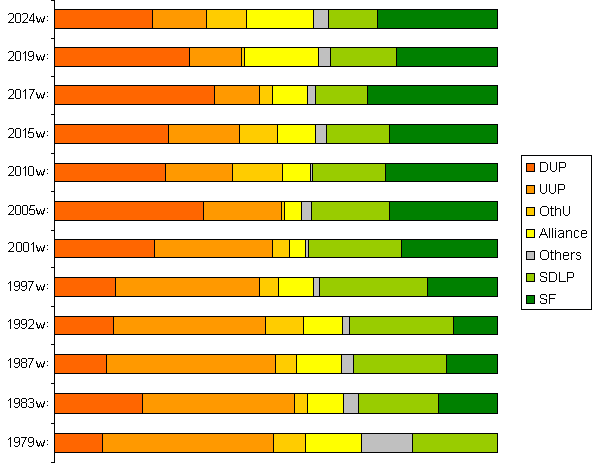

 |
 |
|
|
|
|
|
|
|
The details of each seat are on the relevant page; the totals for the whole of Northern Ireland were as follows:
| Party / Candidate | Votes | % Share | (+/-) | Seats Won | |
| SF | 210,891 | 27.0% | +4.2% |
7 MPs (-) | (North Belfast, West Belfast, South Down, Fermanagh and South Tyrone, Mid Ulster, Newry and Armagh, and West Tyrone) |
| DUP |
172,058 | 22.1% |
-8.5% |
5 MPs (-3) |
(East Belfast, East Antrim, East Londonderry, Strangford and Upper Bann) |
| Alliance | 117,191 | 15.0% | -1.8% |
1 MP (-) |
(Lagan Valley) |
| UUP | 94,779 |
12.2% | +0.5% |
1 MP (+1) | (South Antrim) |
| SDLP | 86,861 |
11.1% | -3.8% |
2 MPs (-) | (South Belfast and Foyle) |
| TUV | 48,685 |
6.2% | +6.2% |
1 MP (+1) | (North Antrim) |
| Alex Easton (North Down) | 20,913 |
2.7% | +2.7% |
1 MP (+1) | (North Down) |
| Green Party |
8,692 |
1.1% |
+0.9% |
||
| People Before Profit | 8,438 |
1.1% |
+0.2% |
||
| Aontu |
7,466 |
1.0% |
-0.2% |
||
| Anne McCloskey (Foyle) |
1,519 |
0.2% |
- |
||
| CCLA |
624 |
0.1% |
- |
||
| Conservatives |
553 |
0.1% |
-0.6% |
||
| Garreth Falls (Strangford) |
256 |
0.03% |
|||
| John Kelly (Mid Ulster) |
181 |
0.02% |
|||
| Ryan North (East Belfast) |
162 |
0.02% |
|||
| Tony Mallon (West Belfast) |
161 |
0.02% |
|||
| Gareth Burns (Strangford) |
157 |
0.02% |
|||
| Tristan Morrow (North Antrim) |
136 |
0.02% |
|||
| Chris Carter (North Down) |
117 |
0.02% |

|
|
|

This map
shows the constituency boundary adjustments
Other sites based at ARK: ORB (Online Research Bank) | CAIN (Conflict Archive on the INternet) | Northern Ireland Life and Times Survey
Your comments, please! Send an email to me at nicholas.whyte@gmail.com.
Created by
Nicholas Whyte and Conal Kelly, 5 July 2024.
|
Disclaimer: Nicholas Whyte 2005 Last Updated on
Sunday, 09-May-2010
21:59
|